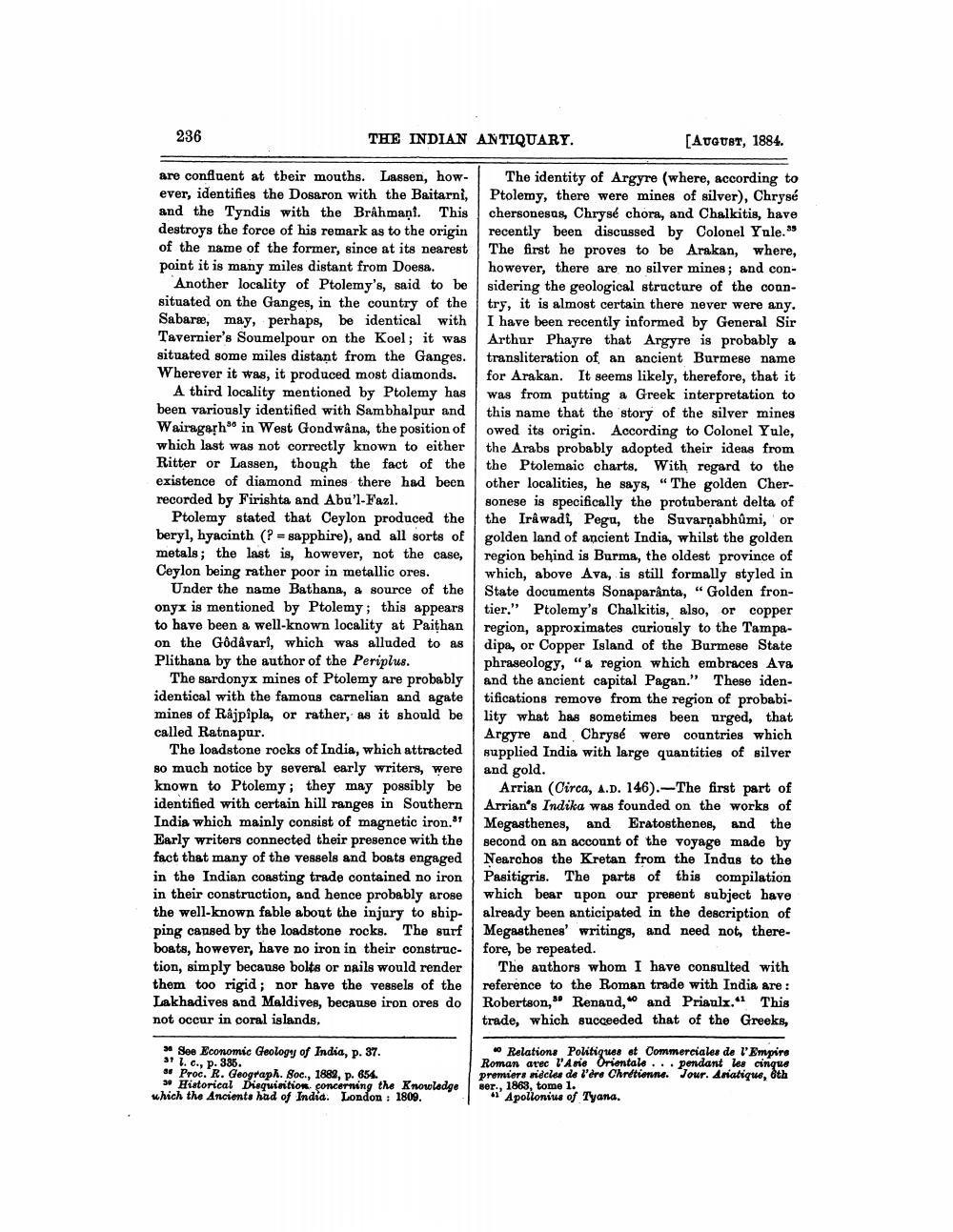________________
236
THE INDIAN ANTIQUARY.
are confluent at their mouths. Lassen, however, identifies the Dosaron with the Baitarni, and the Tyndis with the Brahmani. This destroys the force of his remark as to the origin of the name of the former, since at its nearest point it is many miles distant from Doesa.
Another locality of Ptolemy's, said to be situated on the Ganges, in the country of the Sabaræ, may, perhaps, be identical with Tavernier's Soumelpour on the Koel; it was situated some miles distant from the Ganges. Wherever it was, it produced most diamonds.
A third locality mentioned by Ptolemy has been variously identified with Sambhalpur and Wairagarh in West Gondwâna, the position of which last was not correctly known to either Ritter or Lassen, though the fact of the existence of diamond mines there had been recorded by Firishta and Abu'l-Fazl.
Ptolemy stated that Ceylon produced the beryl, hyacinth (?= sapphire), and all sorts of metals; the last is, however, not the case, Ceylon being rather poor in metallic ores.
Under the name Bathana, a source of the onyx is mentioned by Ptolemy; this appears to have been a well-known locality at Paithan on the Gôdâvari, which was alluded to as Plithana by the author of the Periplus.
The sardonyx mines of Ptolemy are probably identical with the famous carnelian and agate mines of Rajpipla, or rather, as it should be called Ratnapur.
The loadstone rocks of India, which attracted so much notice by several early writers, were known to Ptolemy; they may possibly be identified with certain hill ranges in Southern India which mainly consist of magnetic iron." Early writers connected their presence with the fact that many of the vessels and boats engaged in the Indian coasting trade contained no iron in their construction, and hence probably arose the well-known fable about the injury to shipping caused by the loadstone rocks. The surf boats, however, have no iron in their construction, simply because bolts or nails would render them too rigid; nor have the vessels of the Lakhadives and Maldives, because iron ores do not occur in coral islands.
30 See Economic Geology of India, p. 37. 31 L. c., p. 335.
38 Proc. R. Geograph. Soc., 1882, p. 654.
30 Historical Disquisition concerning the Knowledge which the Ancients had of India. London: 1809.
[AUGUST, 1884.
The identity of Argyre (where, according to Ptolemy, there were mines of silver), Chrysé chersonesus, Chrysé chora, and Chalkitis, have recently been discussed by Colonel Yule." The first he proves to be Arakan, where, however, there are no silver mines; and considering the geological structure of the country, it is almost certain there never were any. I have been recently informed by General Sir Arthur Phayre that Argyre is probably a transliteration of an ancient Burmese name for Arakan. It seems likely, therefore, that it was from putting a Greek interpretation to this name that the story of the silver mines. owed its origin. According to Colonel Yule, the Arabs probably adopted their ideas from the Ptolemaic charts. With regard to the other localities, he says, "The golden Chersonese is specifically the protuberant delta of the Irawadi, Pegu, the Suvarnabhumi, or golden land of ancient India, whilst the golden region behind is Burma, the oldest province of which, above Ava, is still formally styled in State documents Sonaparânta, "Golden frontier." Ptolemy's Chalkitis, also, or copper region, approximates curiously to the Tampadipa, or Copper Island of the Burmese State phraseology, "a region which embraces Ava and the ancient capital Pagan." These identifications remove from the region of probability what has sometimes been urged, that Argyre and Chrysé were countries which supplied India with large quantities of silver and gold.
Arrian (Circa, A.D. 146).-The first part of Arrian's Indika was founded on the works of Megasthenes, and Eratosthenes, and the second on an account of the voyage made by Nearchos the Kretan from the Indus to the Pasitigris. The parts of this compilation which bear upon our present subject have already been anticipated in the description of Megasthenes' writings, and need not, therefore, be repeated.
The authors whom I have consulted with reference to the Roman trade with India are: Robertson, Renaud, and Priaulx." This trade, which succeeded that of the Greeks,
30
40
Relations Politiques et Commerciales de l'Empire Roman avec l'Asie Orientale... pendant les cinque premiers siècles de l'ère Chrétienne. Jour. Asiatique, oth ser., 1863, tome 1.
Apollonius of Tyana.




